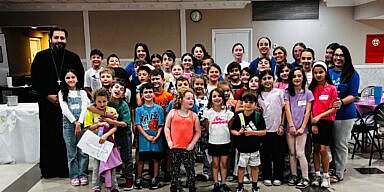Growing up and today, my favorite Greek baking holiday has got to be Easter, or Pascha as it is called in Greek. This time of year makes me feel blessed and grateful for my Greek Orthodox faith and family.
This Easter, I will share the recipe and symbolism of LAZARAKIA, Lazarus buns made for Lazarus Saturday, the last Saturday before the start of Holy Week, and Pascha. These Greek Easter Lazarus breads are fun to make and delicious to eat. They are slightly sweet and filled with raisins, nuts, chocolate chips (or a combination of both). Everyone loves Lazarakia, but if you are baking with young children, they will especially enjoy shaping them and the tradition and meaning behind these sweet little breads.
Traditionally, these sweet breads (lenten because they contain no eggs or dairy) are made in the shape of little men wrapped in a shroud to represent Lazarus himself. Cloves represent the eyes, and the dough is shaped like a body with arms crossed over the chest, forming an X in front. This is meant to represent the shroud wrapped around the deceased upon burial. Often, families will make as many lazarakia as there are children in the family. Younger children may have ideas about how to shape their little Lazarus buns!
The symbolism of the Lazarakia is deeply rooted in our faith. It signifies that, because of Jesus, there is sweetness and joy in eternal life, even during great sorrow and death. This is why Saturday of Lazarus and Palm Sunday are two days of joy between Great Lent and the lament of Holy Week. Lazarakia are a traditionally lenten recipe “nistisima” because they are served on Lazarus Saturday which falls during Great Lent. Sweet but not overly so and flavored with cinnamon and ground cardamom, these Lazarakia buns are delicious. It’s a perfect treat to enjoy during Lent.
On Lazarus Saturday, there is another beautiful tradition, the Lazarines. This involves the singing of the carols of Lazarus. Children, usually only girls and sometimes even young women, gather in the fields on the eve of the Saturday of Lazarus and collect flowers they would then use to decorate their Easter baskets. The girls dressed in traditional local costumes and filled their baskets with lazarakia or other nistisima treats and flowers. They then traveled around the village singing carols to commemorate the joyous feast, offering their lazarakia. These singers were referred to as Lazarines. In return for the carols, they would receive money, fruit, eggs, treats, or whatever else the households they visited would have to offer.
Ingredients
- 1 ¾ cups lukewarm water
- 1 tbsp yeast
- 1 cup sugar
- 1/4 cup and 1 tablespoon olive oil
- 1 tsp cinnamon
- 1 tsp ground cardamom
- 1/4 tsp salt
- 5 ¼ cups flour
- 48 whole cloves
For stuffing
- 100 grams non-dairy chocolate chips (optional) or
- 50 grams each of walnuts and raisins, chopped
Instructions
- Add water, yeast, and sugar to the bowl of your stand mixer and mix well with a fork. Allow to sit for 10 minutes.
1 ¾ cups lukewarm water, 1 tbsp yeast, 1 cup sugar - Combine the dry ingredients in another bowl and mix well.
1 tsp cinnamon, 1 tsp ground cardamom, 5 ¼ cups flour, 1/4 tsp salt - When your yeast is ready, add olive oil & dry ingredients. Beat well using the dough hook attachment of your mixer for 8 – 10 minutes, or until the dough is formed.
1/4 cup and 1 tablespoon olive oil - Transfer the dough to an oiled bowl and cover with plastic wrap. Allow to rise at room temperature for 30 minutes.
- When your dough is ready, divide it into 24 portions of 50 grams each. Then, divide each of these into 40 grams for the body and 10 grams for the arms.
48 whole cloves, 50 grams each of walnuts and raisins, chopped, 100 grams of chocolate chips - Preheat oven to 325 degrees Fahrenheit.
- Shape your Lazarakia. To make the body, use your hand to flatten the larger piece of dough and shape it into an oval. Add about 1 tsp of filling to the center and then close it, pinching the ends and rolling it a bit to seal the seam. It would help if you ended up with an oblong shape. Then, use 10 grams of dough to make the arms, crisscrossing them in the front and back. Insert the cloves where the eyes would be.
- Place your Lazarakia on a parchment-lined baking sheet, leaving space between them as they will rise during baking. Bake for about 20 – 30 minutes, or until golden.



